

RAAF Base Wagga. RAAF Base Wagga (formerly RAAF Base Forest Hill) is located 5.8 nautical miles (10.7 km; 6.7 mi) southeast[1] of the New South Wales town of Wagga Wagga, in the suburb of Forest Hill.
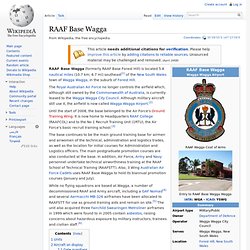
The Royal Australian Air Force no longer controls the airfield which, although still owned by the Commonwealth of Australia, is currently leased to the Wagga Wagga City Council. Although military aircraft still use it, the airfield is now called Wagga Wagga Airport.[2] Australian Defence News & Articles. Wedgetail Byline: Kym Bergmann / Canberra Introduction One of the more complex and fraught Defence acquisitions of recent times has been the purchase of six ‘Wedgetail’ airborne early warning & control (AEW&C) aircraft from Boeing.
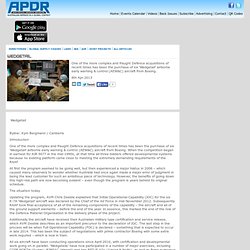
When the competition began in earnest for AIR 5077 in the mid-1990s, at that time all three bidders offered developmental systems because no existing platform came close to meeting the extremely demanding requirements of the RAAF. At first the program seemed to be going well, but then experienced a major hiatus in 2006 – which caused many observers to wonder whether Australia had once again made a major error of judgment in being the lead customer for such an ambitious piece of technology.
Airforce Technology. Boeing 737 AEW&C Wedgetail Early Warning Aircraft. The Commonwealth of Australia placed a contract worth more than $1bn with Boeing in December 2000 for the development and supply of the 737 airborne early warning and control (AEW&C) programme, Project Wedgetail.
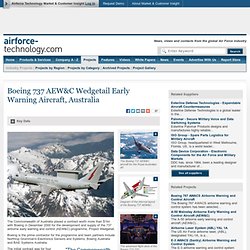
Boeing is the prime contractor for the programme and team partners include Northrop Grumman's Electronics Sensors and Systems, Boeing Australia and BAE Systems Australia. "The Commonwealth of Australia placed a contract with Boeing in December 2000 for the development and supply of the 737 airborne early warning and control (AEW&C) programme, Project Wedgetail. " The initial contract was for four AEW&C systems with options for up to three additional systems. The contract also provides a mission support segment and the associated ground-based support segments for flight and mission crew training. In May 2004, Australia exercised options to purchase an additional two aircraft.
RAAF Wedgetail achieves operational capability standard - Department of Defence. Defence News Home > Defence News Archive > Defence News Published: 20 November 2012 The Airborne Early Warning & Control (AEW&C) Wedgetail aircraft has achieved Initial Operational Capability, providing Australia with the most advanced air battlespace management capabilities in the world.
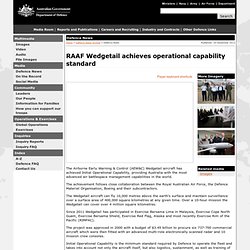
The achievement follows close collaboration between the Royal Australian Air Force, the Defence Materiel Organisation, Boeing and their subcontractors. The Wedgetail aircraft can fly 10,000 metres above the earth’s surface and maintain surveillance over a surface area of 400,000 square kilometres at any given time. Over a 10-hour mission the Wedgetail can cover over 4 million square kilometres. Since 2011 Wedgetail has participated in Exercise Bersama Lima in Malaysia, Exercise Cope North Guam, Exercise Bersama Shield, Exercise Red Flag, Alaska and most recently Exercise Rim of the Pacific (RIMPAC).
Air Power Australia - Home Page. Wedgetail - Australia's “Pocket AWACS” In the nearer future Australian taxpayers should know which of the three Wedgetail bidders will be contracted to supply the ADF's new Airborne Early Warning & Control (AEW&C) system.

Without any doubt, this will be the most expensive and complex platform ever acquired and operated by the ADF, and a decisive battle management asset in any future conflict. For the first ever time, the ADF will have the ability to surveil, command, control and coordinate a joint air/sea/land battle in real time. Until now, whatever capabilities the ADF had to conduct such engagements were dependent upon pooling information from diverse sources, which presents formidable difficulties if a rapid operational level or tactical level response is required. A picture of the battlespace would need to be compiled from a large number of reconnaissance "snapshots", few of which could be delivered let alone assembled into a cohesive picture in real time.
There are fundamental differences in these capabilities. Boeing P-8 Poseidon. The Boeing P-8 Poseidon (formerly the Multimission Maritime Aircraft or MMA) is a military aircraft developed for the United States Navy (USN).

The aircraft has been developed by Boeing Defense, Space & Security, modified from the 737-800ERX. Development[edit] Origins[edit] The Lockheed P-3 Orion, a turboprop ASW aircraft, has been in service with the United States Navy since 1962. In the 1980s, the Navy began studies for a P-3 replacement, the range and endurance of which was being reduced due to increasing weight and airframe fatigue life limitations. E-7A Wedgetail - Royal Australian Air Force. The E-7A Wedgetail represents an entirely new capability for the ADF, providing an airborne early warning and control (AEW&C) platform that will gather information from a wide variety of sources, analyse it and distribute it to all friendly air and surface assets.
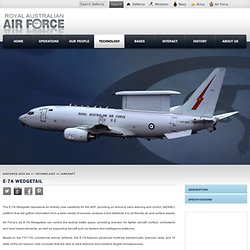
Air Force’s six E-7A Wedgetails can control the tactical battle space, providing direction for fighter aircraft, surface combatants and land based elements, as well as supporting aircraft such as tankers and intelligence platforms. Based on the 737-700 commercial airliner airframe, the E-7A features advanced multirole electronically scanned radar and 10 state-of-the-art mission crew consoles that are able to track airborne and maritime targets simultaneously. The E-7A Wedgetail can elevate its radar to 10,000 metres above the earth’s surface so that the radar can ‘see’ everything out to a range of hundreds of kilometres.
Ac-130 spectre gunship. Raaf firefighters. Australian Defence Force Basic Flying Training School. The Australian Defence Force Basic Flying Training School (BFTS) is located in Tamworth in northern New South Wales.
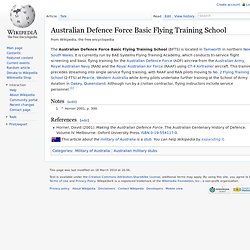
It is currently run by BAE Systems Flying Training Academy, which conducts tri-service flight screening and basic flying training for the Australian Defence Force (ADF) aircrew from the Australian Army, Royal Australian Navy (RAN) and the Royal Australian Air Force (RAAF) using CT-4 Airtrainer aircraft. This training precedes streaming into single service flying training, with RAAF and RAN pilots moving to No. 2 Flying Training School (2 FTS) at Pearce, Western Australia while Army pilots undertake further training at the School of Army Aviation in Oakey, Queensland.
Although run by a civilian contractor, flying instructors include service personnel.[1] List of current Royal Australian Air Force aircraft. This is a list of the current Royal Australian Air Force aircraft in operation: Current aircraft[edit] Future acquisitions[edit] Air 6000 Ph2A/2B: Lockheed F-35A prototype AIR 6000: Lockheed Martin F-35 Lightning II multirole fighter[3][4]A possible total of 100 F-35As are to be purchased under Project Air 6000 to replace the Hornets and Super Hornets.
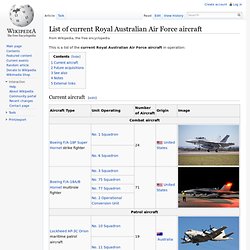
AIR 6000, Phase 2A/2B, Stage 1: 14 F-35A fighters have been approved for purchase for service entry from 2014.AIR 6000, Phase 2A/2B, Stage 2: 58 additional F-35A fighters planned for purchase. List of Australian Air Force Cadet units. This is a list of all Squadrons of the Australian Air Force Cadets (AAFC).
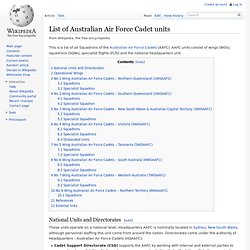
AAFC units consist of wings (WGs), squadrons (SQNs), specialist flights (FLTs) and the national headquarters unit. National Units and Directorates[edit] These units operate on a national level. Headquarters AAFC is nominally located in Sydney, New South Wales, although personnel staffing this unit come from around the nation.
Lockheed P-3 Orion. The Lockheed P-3 Orion is a four-engine turboprop anti-submarine and maritime surveillance aircraft developed for the United States Navy and introduced in the 1960s. Lockheed based it on the L-188 Electra commercial airliner.[3] The aircraft is easily recognizable from the Electra by its distinctive tail stinger or "MAD Boom", used for the magnetic detection of submarines. Over the years, the aircraft has seen numerous design advancements, most notably to its electronics packages. The P-3 Orion is still in use by numerous navies and air forces around the world, primarily for maritime patrol, reconnaissance, anti-surface warfare and anti-submarine warfare.
A total of 734 P-3s have been built, and during 2012, it joined the handful of military aircraft including the Boeing B-52 Stratofortress and Boeing KC-135 Stratotanker that have served 50 years of continuous use by the United States military. RAAF Curtin. RAAF Base Curtin (IATA: DCN, ICAO: YCIN) is a Royal Australian Air Force base located 19 nautical miles (35 km; 22 mi) southeast[1] of the town of Derby on the north coast of Western Australia. As it is one of the RAAF's three 'bare bases' no Air Force units are currently based at Curtin and it is maintained by a small caretaker staff during peacetime.
The base is named in honour of former Prime Minister John Curtin. RAAF Curtin was the first new major military airfield to be built in Australia since World War II. Construction on the base began in 1983 and it was opened on 11 June 1988.[2] The base has only been activated twice by the RAAF.[2] From the late 1990s the base operated as Curtin Immigration Reception and Processing Centre, a Commonwealth of Australia immigration detention centre, which closed in September 2002.[3] However the centre was reopened in April 2010 to house around 60 Sri Lankan and Afghan asylum seekers whose applications were suspended.[4] See also[edit] RAAF Scherger. While the base has facilities to cater for 400 personnel in fixed accommodation, 1,000 personnel in tent lines and about 40 aircraft, it is normally only manned by four Air Force personnel who are responsible for caretaker duties.
During peacetime RAAF Base Scherger hosts, on average, one major exercise per year in which the base is fully activated through the arrival of RAAF units based elsewhere in Australia. In October 2010, the Scherger Immigration Detention Centre was opened at the Scherger RAAF Base, this facility provides accommodation for 300 single adult males. See also[edit] List of airports in Queensland. No. 322 Expeditionary Combat Support Squadron RAAF. Defence of Australia policy. The Defence of Australia Policy was Australia's dominant defence policy between 1972 and 1997. The policy was focused on the defence of continental Australia against external attack. Under this policy the Australian Defence Force was tailored to defending Australia rather than developing capabilities to operate outside Australian territory.
Development[edit] RAAF bare bases. RAAF Learmonth. RAAF Learmonth, also known as Learmonth Airport (IATA: LEA, ICAO: YPLM), is a joint use Royal Australian Air Force base and civil airport. Carnarvon Airport. No. 78 Wing RAAF. Formed as a fighter wing in November 1943, No. 78 Wing comprised three flying units, Nos. 75, 78 and 80 Squadrons, operating P-40 Kittyhawks in the South West Pacific theatre of World War II. Boeing C-17 Globemaster III. Officers' Training School RAAF. History[edit] RAAF College. No. 38 Squadron RAAF. After being re-equipped with de Havilland Canada DHC-4 Caribous in 1964, No. 38 Squadron served as the RAAF's operational conversion unit for the type and also conducted transport tasks within Australia and its territories. Air Force Training Group RAAF. Airfield Defence Guards. No. 79 Squadron RAAF. The squadron was re-formed in its present incarnation during 1998 and is currently stationed at RAAF Base Pearce, where it has operated Hawk 127 jet training aircraft since 2000.
No. 76 Squadron RAAF. No. 3 Squadron RAAF. No. 77 Squadron RAAF. Dassault Mirage III. Aermacchi MB-326. RAAF Base Williamtown - Royal Australian Air Force. RAAF Base Williamtown. No. 81 Wing RAAF. Exercise Pitch Black. Red flag. No. 82 Wing RAAF. RAAF Base Amberley. List of current Royal Australian Air Force aircraft. Lockheed Martin F-22 Raptor. RAAF Base East Sale. Roulettes. RAAF Williams. RAAF Station Parkes. RAAF Base Wagga. RAAF Station Parkes.
Fairbairn, Canberra. RAAF Woomera Airfield. RMAF Butterworth. RAAF Station Parkes. PAC CT/4 Airtrainer. No. 28 Squadron RAAF. RAAF Base Edinburgh. No. 92 Wing RAAF. Air Combat Group RAAF. Air Combat Group RAAF. RAAF Gingin. Boeing 737 AEW&C. BAE Systems Hawk. Pilatus PC-9. Lockheed AP-3C Orion. Lockheed AP-3C Orion. RAAF Base Pearce. RAAF Base Pearce. RAAF Base Darwin. No. 2 Operational Conversion Unit RAAF. McDonnell Douglas F/A-18 Hornet. Jindalee Operational Radar Network. Antonov An-225 Mriya. McDonnell Douglas CF-18 Hornet. Boeing F/A-18E/F Super Hornet. McDonnell Douglas F/A-18 Hornet. Anti-radiation missile. Boeing 707. Boeing 737 AEW&C. Airbus A330 MRTT. Airforce Technology. Gippsland GA10. Next Generation Air Dominance. Boeing F/A-18E/F Super Hornet. List of Royal Australian Air Force air marshals. Future Strategic Tanker Aircraft. Airbus A400M Atlas. Raytheon Sentinel.
Lockheed C-130 Hercules. SEPECAT Jaguar. Eurofighter Typhoon. Laser-guided bomb. Paveway. CAC Winjeel. Noise fears prompt RAAF review of Salt Ash weapon's range. Royal Australian Air Force Flying Area, Williamtown - Royal Australian Air Force. Salt Ash Weapons Range - There's A War On! RAAF Learmonth. Raaf roulettes. RMAF Butterworth.